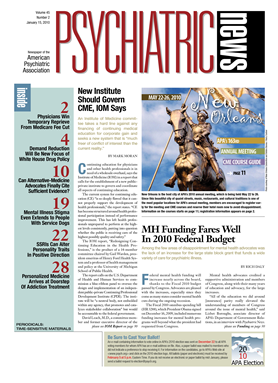During the last two decades, opioid medications have become a common treatment for back pain, musculoskeletal pain, and other types of chronic pain not related to cancer. Now depression has been found to predict the subsequent use of opioids for pain not related to cancer.
This finding was reported in the November-December 2009 General Hospital Psychiatry. The lead investigator was Jennifer Braden, M.D., an acting instructor in psychiatry at the University of Washington.
Braden and her group used claims data and opioid prescription data from some 39,000 enrollees in two large health insurance plans—Group Health cooperative in Washington state and Kaiser Permanente of Northern California—to test a hypothesis. The hypothesis was that there is a link between having received a depression diagnosis in 2003 or 2004 and then using opioids for chronic noncancer pain in 2005.
“We were interested in looking at depression that preceded opioid use,” Braden explained to Psychiatric News. “If we had looked at depression in 2005, it would have been possible that the depression started after the onset of opioid use. Also, we wanted to make sure that the depression was not caused by opioid use, that is, a substance-induced depressive disorder.”
The researchers found that their hypothesis was correct. Enrollees who had received a depression diagnosis in 2003 or 2004 were three times more likely to use opioids for chronic noncancer pain in 2005 than were those enrollees who had not received a depression diagnosis in 2003 or 2004.
Moreover, enrollees who had received a depression diagnosis in 2003 or 2004 were more likely in 2005 to receive higher daily doses of opioids, a larger supply of opioids, and more potent opioids than were those who had not received a depression diagnosis in 2003 or 2004.
And since depression preceded opioid use, it suggested that something about being depressed predisposed people to opioid use for chronic pain.
One possible factor, Braden and her colleagues suggested, is that individuals with depression and noncancer pain are known to suffer more mentally and physically than are individuals with noncancer pain only. So it's possible that clinicians may have prescribed opioids more frequently for them than for individuals with pain only.
In any event, Braden believes that their findings have implications for psychiatrists, since “psychiatrists are very likely to see patients with chronic pain who are on long-term opioid therapy.”
For instance, since depression often precedes opioid use for chronic noncancer pain, it's possible that patients taking opioids for such pain are still depressed. And if that is the case, “it is important that opioids not substitute for, or interfere with, treatment of the depression.” Also, “pain and depression are interrelated in a bidirectional fashion (i.e., depression can worsen pain, and pain can worsen depression), and treatment of both share the common ultimate goals of improving functioning and overall quality of life.”
Yet another finding to emerge from the study, the researchers believe, has implications for psychiatric practice. More than one-third of the depressed subjects who subsequently used opioids also received a supply of benzodiazepines or other sedative-hypnotics for six months or more. Thus, individuals who are depressed and then go on to use opioids for pain may also be using sedative-hypnotics. And since both opioids and sedative-hypnotics are central nervous system depressants, their combined use, especially if taken with alcohol, can slow the heart and respiration and may even be fatal.
The study was funded by the National Institute on Drug Abuse and a Ruth L. Kirschstein National Research Service Award.

